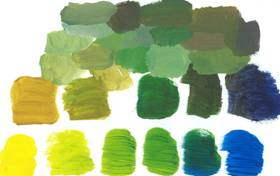Mixing secondary colours
- Wet your brush, being careful not to have it too wet. Squeeze out the excess water or wipe it on your sponge, otherwise your colours will be too runny and lack strength.
 The paint is too wet and runny |
 Just the right amount of water with paint |
- Cool yellow and cool blue have been used to mix green here. You will find that they can make many greens, ranging from lime to almost peacock blue. Find how many different greens you can mix with cool yellow and cool blue.
 Put a dab of yellow in the middle of your palette and, touching the tip of your brush with the blue, mix them together. You can always add more if the first touch is not enough but you cannot take it away! It is quite surprising how strong the dark colours are. Keep adding blue until your mixed colour is nearly dark blue. Then try adding white to it - it should make a lovely aqua.
Put a dab of yellow in the middle of your palette and, touching the tip of your brush with the blue, mix them together. You can always add more if the first touch is not enough but you cannot take it away! It is quite surprising how strong the dark colours are. Keep adding blue until your mixed colour is nearly dark blue. Then try adding white to it - it should make a lovely aqua.
Always add the dark colour to the light when mixing colours.
- Do the same with warm red and warm yellow to make a range of oranges and then with warm blue and cool red to make purples.